Tags
archery, Danshig Naadam, fair, Genghis Khan, horse racing, Mongol Empire, Mongolia, Mongols, Naadam, Three Manly Sports, wrestling
Eight centuries ago, Genghis Khan and his armies rampaged across the steppe in central Asia, conquering lands and peoples to create a Mongol kingdom whose reach exceeded that of any other empire before or since. History gives us a view of the Mongols as vicious and unkempt heathens, but we know from books such as the 13th century The Secret History of the Mongols that cultural life on the steppe was alive and well, ritualized in both athletic and spiritual realms.
Mongolia’s most famous festival, Naadam, has its origins in the steppe celebrations and competitions that began in Genghis Khan’s day, perhaps in concert with weddings and other spiritual assemblies. Then and now, sporting competitions took place in three areas: horseracing, archery, and wrestling. Starting in 1639, these “Three Manly Sports” were integrated into an event called Danshig Naadam, a yearly gathering of nomads, nobles, and monks from across the country to participate in both sports and spiritual activities.
Nowadays, Mongolia aficionados may know that Naadam is held on July 11-13, and in fact, it remains a national holiday on those dates. But that festival – still the most popular time to visit Mongolia – is actually the secular celebration of this ancient gathering. After the 1921 People’s Revolution, the government recast the event as a sporting event only, eliminating the religious and spiritual aspects.
With the end of Communism in 1990 came a return of Buddhism, and the monks and monasteries began to flourish once again. Finally, in 2015, the city of Ulaanbaatar and the monasteries came together to reestablish the original Danshig Naadam festival, held August 6-7, adding back the religious competitions and cultural performances, such as the Buddhist tsam dance, to the Three Manly Sports.
We spent two days enjoying the carnival atmosphere of Danshig Naadam. Like a state fair, the festival is filled with animals, game booths, crafts, picnics, cotton candy, and happy crowds under the beating summer sun.
About an hour outside of Ulaanbaatar, at Hui Doloon Hudag, the main stadium and the other sporting venues became my substitute for the Olympic Games this summer. In marked contrast to that modern extravaganza, however, here the opening ceremony featured bleating Buddhist horns and clanging cymbals, chanting monks, and colorful parades of horses and flags.
Also unlike modern sporting events, the competitors here wear traditional clothing and follow ancient customs as part of their sports. In wrestling, male participants don an unusual outfit of briefs, a skimpy open-chested, sleeved top and leather boots with upturned toes, and they perform an ancient eagle dance before and after they clash. Top-ranked wrestlers choose their opponents, so early matches are uneven and quick, while later ones can be long stand-offs. Matches are not timed, and competitors lose if they touch the ground at any time with a body part other than hands or feet.
Mongolia has a horse-based history and culture; children learn to ride early and are seemingly as comfortable on horses as we are in chairs. The main horse race at Danshig Naadam is a 30-km cross-country event with children aged 5-13 as jockeys. By the end of that age range, many children are already too heavy, so the races are usually won by tiny youngsters. We stationed ourselves near the finish line and, true to form, this year’s winner looked like a 6 or 7-year-old boy, galloping in a cloud of dust as he whipped his mount to victory. Boys and girls compete together in this race, and many of the top finishers we saw were female.
Men and women both compete, but do so separately, in the archery tournaments. The handmade bows and elegant costumes captivated me so much I don’t even know who won these events! Men shoot from 75 meters and women from 65 meters; both are so accurate that officials stand right near the targets to repair the walls after a hit.
Danshig Naadam was a great way to experience Mongolian culture, ancient and current. Families rode in from near and far, on horses or in pick-ups, and set up tents for the festivities. Competitors and spectators alike were dressed in colorful fashions, and there was a sense of holiday merriment in the air.
I felt very lucky to be part of the real Danshig Naadam festival in only its second year back in existence after its Communist-triggered hiatus. If you have a chance to visit Mongolia in summer, aim for mid-July or early August to take advantage of these fabulous opportunities to mingle with Mongolians at their most famous festivals.
Part of a series of posts on my trip to Mongolia in August 2016. Other posts can be found here:
Framing a House Mongolian Style: https://lexklein.wordpress.com/2016/08/26/framing-a-house-mongolian-style/
A Steppe Out of Time: https://lexklein.wordpress.com/2016/08/19/a-steppe-out-of-time/
Ulaanbaatar’s Contrasts and Surprises: https://lexklein.wordpress.com/2016/08/16/ulaanbaatars-contrasts-and-surprises/
Nothing Narrow Here: https://lexklein.wordpress.com/2016/08/01/nothing-narrow-here/
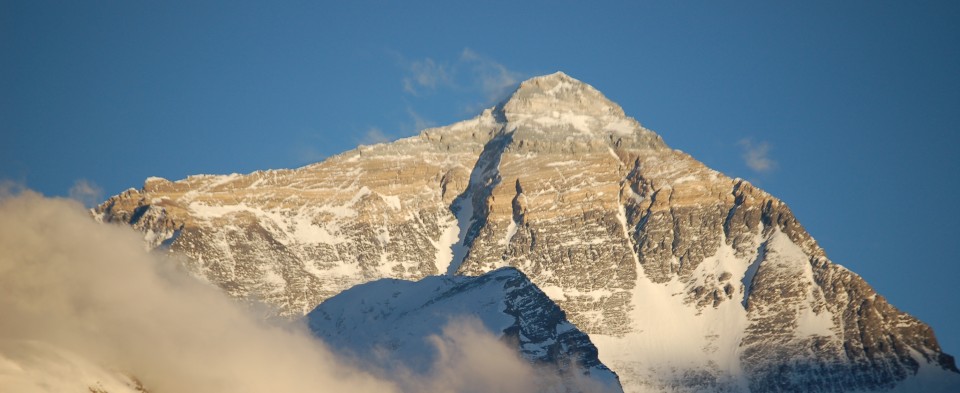

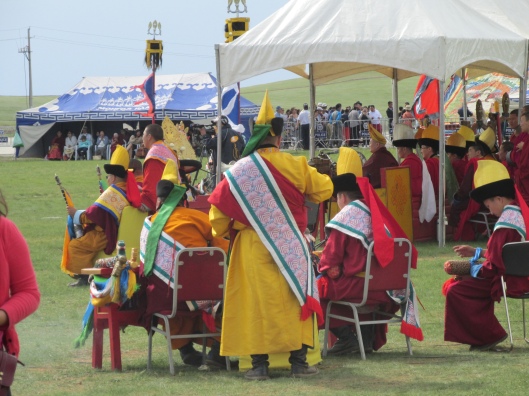



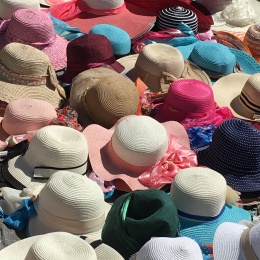





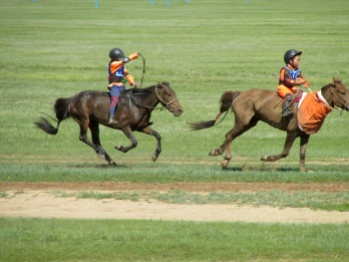

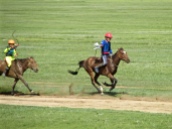


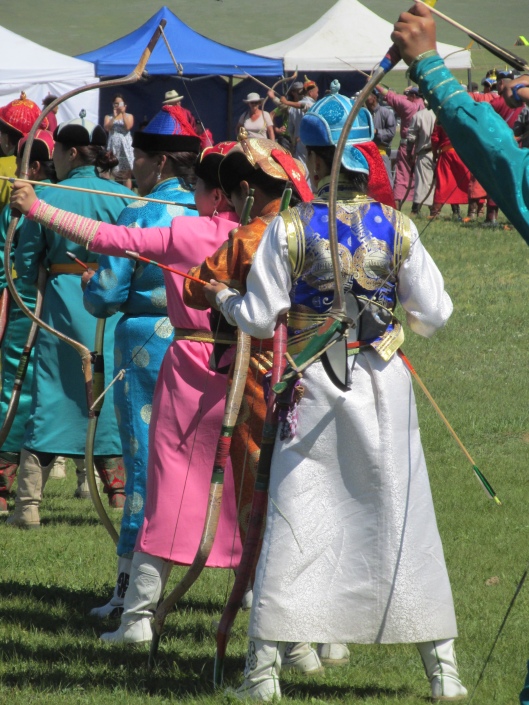
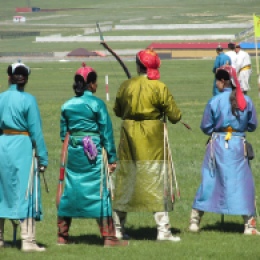










Pingback: Framing a House (Mongolian-Style) | One Foot Out the Door
Those Mongolian kids with their horses are similar with children who live in tiny remote islands with their boats. Their vehicles have become part of their life so much so they become inseparable. I guess a Mongolian kid without his or her horse is like a New Yorker or a Hong Konger without the subway/MTR. Speaking of the archery, it’s a bit scary to see the distance between those officials and the target. But in a way it shows their confidence of the archers’ skills. A fabulous post, Lex!
LikeLiked by 1 person
Thanks, Bama! Yes, it’s amazing what kids learn in different places – things that seem impossible at their ages to those of us from very different cultures. Modern U.S. parents are so hovering and overly careful, it’s hard to imagine letting a small child gallop away on a horse or set sail in a boat!
LikeLike
Having read your blog and seen the photos, Lex, I think I would opt for the Danshig Naadam festival over the Olympics. I really smiled when I saw the kid on the camel. Great post! –Curt
LikeLiked by 1 person
I felt the same way, Curt, although it felt weird to not see a single event of the Olympics! Danshig Naadam was such a low-key festival – just families and others milling about, eating, watching events, and playing simple carnival games. The religious aspect was a little different, but Buddhism is very much part of everyday life, and vice versa – not something so separate and holy as other religions – so it still had that festive, inclusive air. I loved spending a few days outdoors at this fun event!
LikeLike
Were there many other ‘outside folks’ there, Lex?
LikeLike
I love hearing about the resurrection of cultural traditions. The kids on the horses are so impressive. If I ever make it to mongolia, I will try to go at this time.
LikeLiked by 1 person
I was so bummed to miss Naadam in July, and I thought this one would be some hokey tourist version in August. I was thrilled to learn of its origins as the real, original Naadam of centuries past and to be there for only the second annual attempt at this broader event.
LikeLike
Did you try hushuur (fried dough filled with meat)? It’s the Naadam specialty!
LikeLiked by 1 person
I did “eat” this (filled with mutton), but as a vegetarian I managed to accidentally spill (ha) some of the meat onto my napkin. The dough was very flavorful – probably because it had soaked up all the meat juices! When in Rome …
LikeLiked by 1 person
Huushur is delicious but I can only eat one or two because they are filled with oil!
LikeLiked by 1 person
What a time you had! 🙂 🙂
LikeLiked by 1 person
I really did! It was such a fascinating and totally different place. My favorite kind of destination!
LikeLiked by 1 person
Lexie, I know very little about Mongolia, and am enjoying reading your posts. The colors against the rolling, incredibly green steppes is a wonderful contrast. And I love the straw hat photo. Great photos and very well done. ~James
LikeLiked by 1 person
Thank you, James! The only thing I knew about Mongolia before I booked my trip was how much I wanted to see the steppe and learn about the herders’ lives. Everything else was pure icing on the cake. I read half a dozen books before I went and learned that there was so much more to see and learn about this country that so few people know much about. It exceeded my expectations!
LikeLike
Oh yeah I would love to see this. What an amazing time it must have been. Those child horse racers! One at least was even riding bareback. Love the costumes of the archers. And love that women get to fully compete too. And cute wrestlers 🙂 (jk)
Alison
LikeLiked by 1 person
It was so much fun, Alison. Like going to a big field party/carnival with half of it seeming current and familiar (cotton candy, balloon darts, food stands) and half seeming out of another century and place entirely (monks blowing horns, men in long robes and pointy hats, horses among the cotton candy!). Those little riders were incredible – mostly bareback but even when there was a saddle, it was a thin cloth – nothing padded really. I was so lucky to be able to catch this.
LikeLiked by 1 person
What a wonderful post that enables us to have a glance towards Naadam! Nothing can be more fascinating than travelling to one place and experiencing heart-warming atmosphere of such traditional festival!
LikeLiked by 1 person
I agree! It brought back childhood memories of these kinds of outdoor events but with a very foreign twist! I enjoyed every minute of it.
LikeLiked by 1 person
Mongolia…it always seemed so far away, so very exotic, unreachable. I wanted to go, but never wanted to live in a yurt, so never made it there. Your post is having the affect of changing my mind, making me think about going there. Love the kids on horses–reminds me of Native Americans (probably very similar cultures, or the same?). This also reminds me of Bhutan, but it’s even better…because in Bhutan, they wear their traditional clothes, but with Western pointy shoes. Incongruent, and odd. I’ve missed many of your posts, will try to catch up!
LikeLiked by 1 person
Nice to see you back! I agree that much about the country and culture seems Native American – which probably makes sense given the geography and the cultural significance of living off the land. Many of the scenes in Mongolia could have been in Montana. Of course, the Buddhist influence made the whole thing much more exotic (in my eyes) and more similar to Bhutan or Tibet. You should go! And trust me, staying in the gers was a highlight – they are so comfortable and cozy!
LikeLiked by 1 person
A “gers” is a yurt? Actually, I would like to stay in one. I used to live in a teepee during my years in Colorad in the 70’s. I like round things. Most likely the ancestors of Native Americans came across the land bridge long before there was a Buddha, eh?
LikeLiked by 1 person
What amazing pictures, especially the horse race. Thanks for the back story on the Naadam. I found it really interesting.
LikeLiked by 1 person
Thank you! It was hard to summarize such a huge cultural event in a short post (which is why it probably didn’t end up being up short – haha). It was just such a great mix of sports, culture, history, being outdoors, and even a little dose of religion!
LikeLike
So much color! How fantastic to be there to take in these festivals. From your earlier posts I imagined a quiet land with only the sound of the breeze to break the silence. Seeing the people in traditional dress enthusiastically participating has left me with a far different image. Note to self about the timing of a visit.
LikeLiked by 1 person
The difference between the countryside and the capital can seem stark in many ways; however, Naadam is celebrated in July in many smaller towns, too, and even just on the edges of Ulaanbaatar, people are living in gers. So nomadic life and its ancient rhythms and practices still pervade much of the country!
LikeLike
Absolutely fascinating Lexi! It must have been pretty cool to see this festival. Were there other foreigners there or not many? I can imagine not many tourists get to go to Mongolia!
LikeLiked by 1 person
I would say I was surprised to see ANY foreigners there, but yes, we did see a few. Mostly dreadlocked millennials and, oddly, some older people. I am guessing the latter are here because (a) they have the time and money and (b) they’ve already been a lot of places – Mongolia is generally not one’s first (or 10th!) trip overseas!
LikeLiked by 1 person
I would love to check it out! Sounds so fascinating!
LikeLiked by 1 person
Beautiful, absolutely beautiful! That’s a festival I wouldn’t want to miss… Did they also do archery on horseback, by any chance?
The photo of the two boys – brothers I assume – posing up for you was brilliant 🙂
LikeLiked by 1 person
Thanks, Fabrizio! Archery on horseback was big back in the conquering days, but I think now it is more of a “show” than a competition. We did not see it, although I understand they are deadly accurate while riding or even standing on a horse. All of the children I saw in Mongolia were beautiful, and these two brothers were so adorable in their traditional dress. The little guy on the horse was super cute and had some funky pendant hanging down on one side of his head. (I wanted it!)
LikeLiked by 1 person
THe photos are beautiful. The colors of the outfits and flags are great too. Thank you for the historical information. Do the children practice archery too?
LikeLiked by 1 person
Good question! I believe children do participate in archery at the Naadam festival in July and I have seen photos of little kids with tiny bows, but they did not compete at Danshig Naadam as far as I could see. Thanks for your nice comments!
LikeLiked by 1 person
Thank you. No problem, thanks for the response and interesting post. I always wanted to learn archery as a kid.
LikeLike
Ah! Another fantastic post, Lex. You’ve managed to capture the local life, history, and culture beautifully. 🙂 Although, I’m trying hard not to feel sore of what we could have seen. So near and yet so far. 🙂
LikeLiked by 1 person
Thanks a lot! It was so colorful, it was bound to produce some fun photos. Jump on a plane soon – before it gets cold there!
LikeLiked by 1 person
Amazing and intriguing photos, Lex. They really tell your story.
LikeLiked by 1 person
Thank you, Jane. Of course, I was terribly snap-happy at that event; I think I have hundreds of the archers alone! It was a very cool way to really feel a part of Mongolian culture while we were there.
LikeLiked by 1 person
Fantastic post, Lex! I didn’t know about there being two festivals, with the one in August being so new. Thanks for sharing that discovery. It gives us a little more flexibility knowing there is more than one option. Your posts are inspiring me to keep Mongolia at the top of my wishlist. Can’t wait to go someday (soon)!
LikeLiked by 1 person
Thanks, Kelly! I didn’t really know this either, although I did know my trip included some type of ‘Naadam’ festival, which I assumed was bogus since it was not at the right time. I was so thrilled to find that I was attending a “real” event – in fact, in many ways more like the original one. And you know that while I am inspiring you to go to Mongolia, you are doing the same to me with Cuba!
LikeLiked by 1 person
I’m (literally) laughing that you assumed the Naadam festival you were going to see was bogus. I would have assumed the same — like it would have been a village where you go and pay for an “authentic” performance or something. Awesome that you were pleasantly surprised. 🙂 Yep, mutual inspiration is such a cool thing!
LikeLiked by 1 person
Haha – exactly!
LikeLike
How lucky are you that you were there for the ‘real Naadam’ festival now in its second year. Gosh I love when that happens (show up somewhere and get treated to the most awesome thing ever). I especially love the colors and the kids on horseback but the archery and wrestling photos were cool too. Now I want to go here more than ever! Doesn’t get better than this!
LikeLiked by 1 person
I so agree – I honestly thought I was in for some kind of touristy performance but got serious, chanting monks and all the real events, plus the whole outside-the-stadium carnival scene. That assembly of local people was really the best part – just watching families walking around together, seeing the nomads ride in and set up their tents, etc. I loved it!
LikeLiked by 1 person
#jealous but really happy for you‼️
LikeLiked by 1 person
You’re looking at komodo dragons – c’mon! I’m the #jealous one!
LikeLiked by 1 person
😄
LikeLike
I have always been so fascinated with Mongolian culture. This is so fascinating (and informative!). How incredible- thank you for sharing!
LikeLiked by 1 person
Thank YOU for reading and commenting! I had always been fascinated, too, but in kind of a surface way – I knew enough to picture nomadic people ranging over a rolling green land framed by mountains, but my actual knowledge was limited. Before I went, I read some great books about the history and culture, and then I was really hooked! The trip itself was a dream – I hope you can get there someday!
LikeLiked by 1 person
Ahh I hope so too! Have a wonderful week, Lex!
LikeLiked by 1 person
Oh wow, it was a good timing for you to be able to see it. Did you do it on purpose or was it a perfect coincidence ?
LikeLiked by 1 person
I knew from my itinerary that there was some sort of “Naadam” festival that I would be seeing, but I thought it must be something touristy and fake because I knew that the national holiday for Naadam was July 11-13. I went to Mongolia mainly for the time in the countryside, on the steppe, so anything else that was mentioned I did not pay much attention to. When I learned that this festival was centuries old and in some ways even more significant than the “real” Naadam, I was pretty psyched! Long answer to say I was just lucky!
LikeLike
Oh wow, that is very lucky indeed 🙂 I love these kind of coincidence. Did you try some archery over there ? 😀
LikeLiked by 1 person
No, I just watched. I do enjoy archery, though (for a short time, and then my fingers get flayed!)
LikeLiked by 1 person
We’ve tried a session of archery not so long and it’s way more difficult that it seems 🙂
LikeLiked by 1 person
Pingback: Missing Mongolia | One Foot Out the Door
I missed this one when you first posted it, I’m glad you linked back to it. I think for me this would have been the highlight of the trip; the people, the colors, the sounds, the events – I could see myself going from one venue to the next with a big smile on my face.
LikeLiked by 1 person
It was definitely the highlight of being back in the general vicinity of the capital. I don’t know if you grew up going to any state or county fairs, but this reminded me of those – all the animals, the kids, the cotton candy, the games, etc. What made this one unique was the fact that it’s organized by monks, so there’s so much pageantry and music pulsing in the background of all the events. It was really great!
LikeLiked by 1 person
An impressive share! I have just forwarded this onto a coworker who was conducting alittle homework on this. And he in fact bought me breakfast due to the fact that I found it for him… lol. So let me reword this…. Thanks for the meal!! But yeah, thanx for spending the time to discuss this topic here on your web page.
LikeLiked by 1 person
Thanks! Glad to hear my blog is also helping feed people! 🙂
LikeLike
I’d venture that this article has saved me more time than any other.
LikeLike